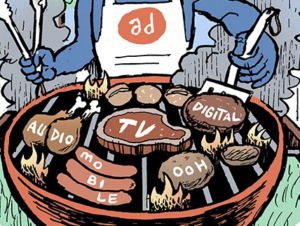Most of us have encountered a website so bogged down with ads that the content’s barely legible. To monetize each of those ad slots, the site has to call thousands of servers to find demand.
It’s a classic example of how an unwieldy, overly complex system leads to both a terrible user experience and generates high scope 3 emissions, which are downstream emissions that stem from activities not directly related to a company’s own actions.
The programmatic supply chain is a poster child for scope 3 emissions.
“We saw [a website] with 28,000 auctions,” said Anne Coghlan, COO and co-founder of sustainability startup Scope3. “We thought it was a bug in our code, but it was not.”
On Monday, Scope3 made its carbon emissions data open to the public to more clearly expose the sources of emissions – and so anyone can understand which players are doing well (or not) with their carbon footprint.
Previously, only Scope3 customers could view and use this data.
Compare and contrast
Scope3 exposes carbon emissions for close to a million apps, websites, social platforms and tech providers across the media supply chain by looking at their ad selection, media distribution and creative delivery. The platform might pull information such as how a company’s servers work, how they’re sending bid requests or how much carbon it takes to show a creative asset based on computing power and bit rate.
Publishers can see the emissions breakdown for their own advertising practices and how their emissions compare to peers. Agencies that are advising brands can use the data to decide where to remove waste, while media buyers can evaluate partners based on their emissions.
“Buyers are starting to compare and understand where there are pockets of really high-emissions inventory that they’re buying from, but that they didn’t know was a problem,” Coghlan said.
Since Scope3 has insight into roughly 30 different markets, people can also see shifts in publisher supply chains depending on the countries they’re operating in. For instance, a global website like MSN has a different supply makeup in the US versus the UK or Australia.
Different counties have varying levels of available emissions data. For instance, in the US and UK, it’s possible to access emissions data broken down by region. Switzerland only publishes its data on how green its electric grid is offline, making it more difficult to collect. Where gaps exist – Japan and Brazil have fewer good signals, for example – Scope3 works with partners to strengthen the data.
Whereas the environmental effects of a company’s direct scope 1 emissions are often visible and tangible – when flying around the world, for instance, you can see the smoke contrails coming out of an airplane – digital emissions by comparison can feel “ephemeral,” Coghlan said.
But they are no less real. The tiny grams of carbon that individual bid requests generate can quickly add up, she said, especially as partners pass bids to resellers.
By opening up its data, Coghlan said, Scope3 wants to ensure that “we’re all speaking the same language about what we’re measuring and how we’re tracking reduction” as the industry moves toward setting consistent sustainability standards.
A more sustainable future
Future PLC, a UK-based media and publishing company with more than 100 properties, started using Scope3’s platform about three months ago.
Using a visualization of the partners, resellers and direct line items in its Ads.txt file as a guide, Future was able to reduce its output of grams of carbon dioxide per 1,000 impressions by 75%.
Future accomplished this reduction by migrating to Prebid, removing multiple partners from its ad stack and prioritizing direct relationships over resellers in open auctions, said Nick Flood, Future’s director of global ad product and revenue operations.
Future is also focusing on bigger partners while still making room for “new upstarts” to ensure a diversified mix of demand sources, said Flood, who noted that these efforts haven’t had a negative revenue impact.
Flood predicts a continued industrywide shift from open auction activity to green PMPs, curated marketplaces and direct buys with publishers. And a company’s emissions number will become “a default trading mechanism,” he said, with advertisers signing off on media campaigns based on a publisher domain’s sustainability credentials.
But knowing exactly where emissions are coming from throughout the digital advertising ecosystem is a prerequisite to motivating meaningful change, Coghlan said.
Scope3 launched APIs to measure programmatic display in March 2022 and apps toward the end of last year. This year, it’s been in open beta with CTV measurement data since April and closed beta for audio and social since July. It’s continuing to add channels, with DOOH on the docket.
“When we’re talking about supply chain emissions, it’s that connectivity that makes all the difference,” Coghlan said.
The same could be said of the digital advertising industry’s will to embrace sustainability.
















